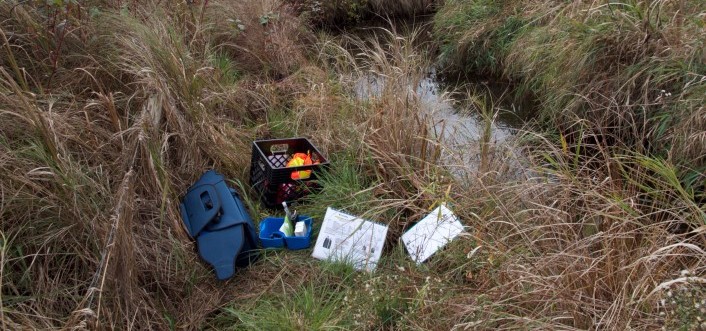Citizen science demonstrates the power of volunteers to make a difference to our natural environment. Learn about our Water Quality team from our volunteer interns.
On a warm July day a lone crayfish scuttled across the bottom of the creek it called home. It had just come across an algae covered rock to graze on, when suddenly a huge ripple in the water passed it over. Quickly, the crayfish retreated under the cover of some dead leaves to hide from the interloper. After a moment, the crayfish peeked out from its hiding place to see what had caused the ripples in the water. What it saw was two humans. One was standing in the stream, taking some containers and filling them with water. The other was standing on the bank, looking around and writing notes down on a piece of paper. Though the crayfish couldn’t make much sense of what these people were doing, it made perfect sense to them. They were members of the Carden Water Quality Monitoring Team, and they were just starting out on a project that would help to learn more about the water in their area.
The project began as a way to determine if fencing cattle out of waterways would help to improve the quality of water in the Talbot River. However, the health of our waterways is part of a much bigger picture. Fresh, clean water provides a home for the fish we eat, a place for children to play and a ready source for all to drink. Despite the importance of water monitoring, it can be a challenge to collect water quality data over a wide area, or a long period of time. This type of data collection is simply beyond the scope of a single scientific study, or a lone research team.
“Citizen scientists gain not only valuable scientific information,but an understanding and respect for the environment around them”
However, with the help of local volunteers, monitoring changes in water quality over time becomes a possibility. These citizen scientists gain not only valuable scientific information, but an understanding and respect for the environment around them. This is where our water teams come in. Twice a month, each team visits our water testing sites spread throughout the Talbot River watershed. Armed with field testing kits, we record readings for many water quality parameters. Among them are phosphates and nitrogen: both components of fertilizer and manure. Gathering information on the levels of these elements in the water is vital to determining the health of the watershed, and the effectiveness of the cattle fencing efforts.
“Knowing that each of us had helped create a baseline for what water quality looked like at our sites, and by extension in the watershed, helped to renew our enthusiasm for the coming year of water testing.”
Towards the end of 2015, the water teams gathered once more before breaking for the winter season, to put our data together to see what we had learned in our first year of sampling. Our partners at Ontario Streams helped us to see the big picture that our individual monitoring efforts had created as trends in water quality came to light. This meeting also gave us the chance to share our observations of the environment surrounding our testing sites, which provided insight on the reasoning behind our results. Knowing that each of us had helped create a baseline for what water quality looked like at our sites, and by extension in the watershed, helped to renew our enthusiasm for the coming year of water testing.
Now the second year of water testing is upon us. It is time to dig out our rubber boots and hip waders and head out to the river we have grown to know and care for. Stepping into the cool waters once again, we continue to work towards a future that is bright for humans and crayfish alike.
Meagan Coughlin and Aiesha Aggarwal are volunteer interns at The Couchiching Conservancy.


